Bill Jerry's 1932 Ford Roadster
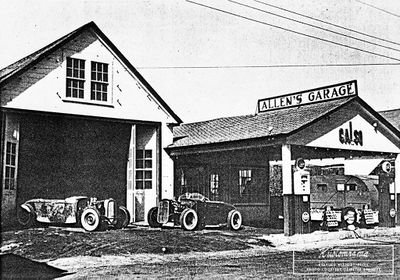






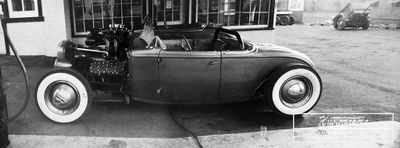






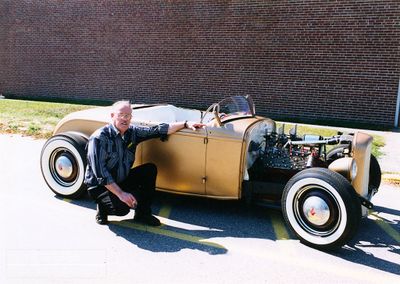
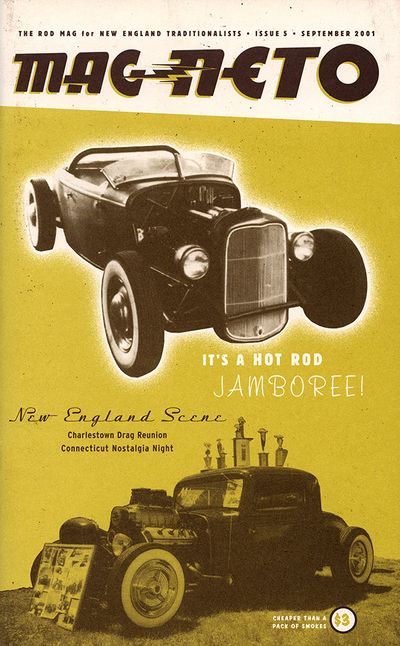
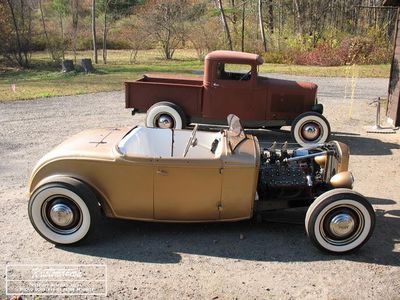



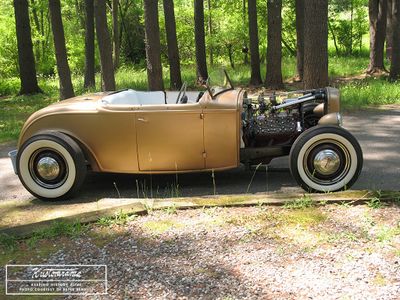
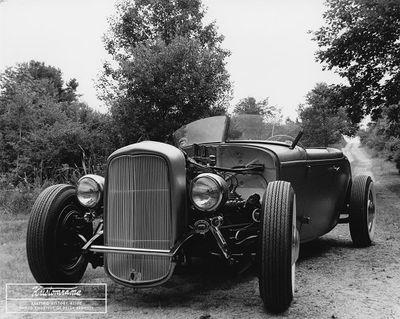
1932 Ford Roadster owned and built by Bill Jerry of Jay, Maine. Jerry started the build in 1949. Back then, he raced around town in a chopped and channeled 1932 Ford 5-Window Coupe. In 1951, he shifted his focus from the Coupe, acquiring a damaged 1932 DeLuxe Roadster body. He removed the Coupe body, cut the floor out, and dropped the Roadster body over the Coupe frame. The body was channeled 6 inches over the frame, the frame was Z'ed 6 inches behind the B-pillar, and the rear frame horns were bobbed. Jerry built a 4" well casing for the rear cross member and an adjustable spring perch. This marked the first significant modification to what would become a long-term project. "The 5-Window Coupe body and the stock chassis were sold down the road," later owner and caretaker Peter Bennett told Sondre Kvipt of Kustomrama in 2024.[1]
Contents
Modifications and Improvements: The 1950s
Jerry drove the roadster around while working on it. By early 1952, the car underwent a substantial aesthetic update, receiving a fresh coat of paint at a local Chrysler dealership. The interior saw upgrades with yellow boat cushion seats stitched by Jerry's boss’s wife, Barbara. A new 276 CI engine painted Ford Hawaiian Bronze was installed, enhancing the car's performance. These improvements were complemented by a black-painted frame, a 2 1/2" dropped axle from California, 1940 Ford brakes, backing plates, drums and wheels. Jerry ran 600x16 whitewall tires up front, and 650x16 whitewall tires in the rear. The wheels were dressed up with late Ford hubcaps. The spindles were altered 1937 - 1941 Ford spindles. It ran aircraft-style shocks, owner made brackets, and a custom made draglink by Jerry. The steering box was from a Hudson Terraplane, and it ran an altered pitman arm. The stock wishbone was split and mounted with homemade brackets. Jerry also made the mounting brackets for the 1939 Ford radiator and the stands for the aftermarket Guide sealed beam headlights. The firewall was chopped, and the stock pedal assembly was modified and mated to a 1940 Ford master cylinder. Inside, it was dressed up with a 1940 Ford Deluxe dash and mirror and a 1939 Ford Deluxe steering wheel. The windshield frame was from a 1946 - 1952 Chris Craft Runabout. The roll bar was homemade. The deck lid featured 1937 Ford hinges. 1946 - 1948 Ford taillights and a Hollywood accessory plate light rounded out the initial series of enhancements.[1]
The Roadster in Racing and Business
During the early 1950s, Jerry actively raced the roadster, continually upgrading its engine and performance capabilities. The ultimate iteration included a blown 296 plus .030 inch engine with four Stromberg 97 carburetors, Offy heads, and a magneto system. Jerry provided some fascinating insights into the specifications of the upgraded engine to later owner Peter Bennett, which he described as "an animal." The engine, a 1948 Mercury 296 cubic inch with a .030 overbore, featured an Isky 404 cam with radius lifters, large valves, relieved guides, reinforced valve springs, and a lightened and polished crankshaft. The ports were enlarged and matched to the blower intake, with every component polished for optimum performance. Additionally, it was equipped with a big oil pump and an H+C magneto. The drivetrain comprised a competition clutch and an Auburn pressure plate, both custom-built by Bill, powering a locked rear differential through a 1939 Ford transmission with Lincoln Zephyr gears he engineered himself. The gas tank, drive shaft, torque tube, rear end, and springs were also 1940 Ford. Despite the impressive build, the engine was never fully tuned to its potential. Bill acknowledged mixed feelings about this; although it was a point of disappointment, the demands of a growing family limited the time he could dedicate to perfecting the roadster. During one of his and Peter's conversations, he reminisced, "The engine made 250 horsepower before fuel. Just imagine how that beast would run!" As Jerry transitioned to running his own transmission building and repair business, the time and attention he could dedicate to the roadster diminished. By the mid-1960s, the car was relegated to storage at the back of his shop, marking the beginning of a dormant period.[1]
Period of Neglect: The Late 1960s and Beyond
The roadster changed hands in the mid-1960s, but the new owner soon damaged the engine, leading to its removal. The car was then stored in a basement garage, largely forgotten and inaccessible, hidden behind a bricked-up door. It wasn't until the mid-1970s that the roadster saw potential rejuvenation when one of Jerry’s employees, advised by Jerry, expressed interest in the car. Despite significant challenges, including the need to remove structural parts of the car to transport it through a narrow doorway, the car was successfully extracted from its confined space. The condition of the roadster was sad. The motor was lost, the interior was totally trashed, the windshield was gone, the radiator was gone, the tires were flat and beyond repair, the hubcaps were gone, and the paint was damaged. But it was a channeled '32 Roadster.[1]
A Revival Attempt
After its recovery, the new owner repainted the car in black primer and replaced the original engine with a stock runner, slowly adding modifications like heads, carbs, and headers. The roadster became a fixture at local car club events throughout New England and eastern Canada. It continued to be used vigorously until it was parked in the late 1980s, following which it remained unused for nearly a decade.[1]
Preservation and Current Status
Following the owner’s death, the widow stored the roadster in a carriage house, where it remained covered until discovered by Peter Bennett of Portland, Maine, circa 1990-1991. Bennett found the car in a state of neglect but recognized its historical and personal value as a testament to Bill Jerry's original vision and dedication. Bennett purchased the car circa 1993, and he spent a year and a half restoring it. "I did little to the body so all the physical history would remain. The dent in the rear 1/4 from the bucks rack." It was also driven in the winter, so the same quarter panels have the thrash from the tire chains. Bennett worked in the field of restoration and conservation of decorating finishes, so he tested the primer to see if it could be removed, leaving the underpainting intact. It didn't work, and since his wife Michele in a gilder and a conservator, gold was a natural and different choice for the car at the time. "The original green paint is under the gold, the windless between the dash and body is still the yellow of the interior, and so on." By 1995, it featured a flat gold paint job, pinstriping by Larry Hook, and a newly built 1939 Mercury motor that Bennett bored 30 over stock and hopped up with an original Ed Winfield SU-1R cam shaft, original Johnson lifters, enlarged exhaust ports, vintage tube headers, Offenhauser 8 1/2:1 period heads, an original Eddie Edmonds regular intake, two Stromber 97s, Mallory electronic ignition, a lightened flywheel, truck pressureplate and clutch. It ran commercial glasspack mufflers and an owner built exhaust system. Bennett still owned the car in 2024. By then, the old hot rod had seen many roads, drag strips, and shows. "It still handles great. It is still beautiful and still ready," Peter told Kustomrama.[1]
References
Did you enjoy this article?
Kustomrama is an encyclopedia dedicated to preserve, share and protect traditional hot rod and custom car history from all over the world.
- Help us keep history alive. For as little as 2.99 USD a month you can become a monthly supporter. Click here to learn more.
- Subscribe to our free newsletter and receive regular updates and stories from Kustomrama.
- Do you know someone who would enjoy this article? Click here to forward it.
Can you help us make this article better?
Please get in touch with us at mail@kustomrama.com if you have additional information or photos to share about Bill Jerry's 1932 Ford Roadster.
This article was made possible by:
SunTec Auto Glass - Auto Glass Services on Vintage and Classic Cars
Finding a replacement windshield, back or side glass can be a difficult task when restoring your vintage or custom classic car. It doesn't have to be though now with auto glass specialist companies like www.suntecautoglass.com. They can source OEM or OEM-equivalent glass for older makes/models; which will ensure a proper fit every time. Check them out for more details!
Do you want to see your company here? Click here for more info about how you can advertise your business on Kustomrama.





